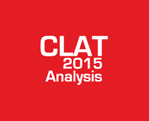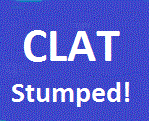CLAT 2015 has two firsts to its credit – one, it is the first Computer Based CLAT and second it has removed the age limit for CLAT applicants and allowed me to take the paper. So here is my take of my debut CLAT.
CLAT 2015 was not a lengthy paper and students would not have struggled for time but there were surprises in all sections. The language of many questions was not upto the mark and I wondered if proof-reading was done before releasing the paper. Also it appears that the people who created the paper are in awe of IIMs and hence put a few questions directly from old CAT papers or maybe NLU Lucknow outsourced paper setting to IIM Lucknow 🙂
English: out of the 40 questions in this section, 20 were based on vocabulary. Synonyms, inappropriate word, analogy and cloze test were all there. Additionally fill in the blanks with common confusable words (further/farther or discrete/discreet) were copied from CAT pattern. Some of the words were difficult but most were do-able. 6 grammar questions completed the usage bit. The RC passage of about 800 words was easy to read and the 10 questions that followed were simple and most students would have got at least 8 out of 10 correct. The remaining 4 questions were an attempt to include mild critical reasoning questions – 2 independent questions on essence of the passage and 2 on the “unreasonable” passage.
Given that there were a few difficult words and a few questions had close choices, I feel that an attempt of 36-38 questions with a net score of 30-32 was possible in this section.
Elementary Maths: this was anything but elementary. This is possibly the most difficult maths section in any law entrance test in India ever. One could have easily mistaken this section to be a practice set for CAT. At least 5 questions in this section were picked up directly from old CAT papers. The surprise (shock) factor in this section was a set of 5 Data Interpretation questions, while the questions were easy it would have taken some time for the students to understand what they are supposed to do. The questions from probability and P&C were also not simple and some of the easy questions were time consuming. The good thing was that you could save time by using the choices.
Given the “CAT” maths in this section not many students would have attempted over 15 questions. A good score in this section would be around 11-12.
Logical Reasoning: As usual this section (along with GK) was the saviour of most of the students. The questions included all the usual suspects like syllogism, coding-decoding, analytical reasoning, directions, relationship etc. The “CATification” of this section was in the form an analytical reasoning set of 5 questions (questions paper leak) picked up from an old CAT paper, there Data Sufficiency type of questions and the three Fact-Inference-Judgement questions.
The analytical reasoning set was time consuming and FIJ are error prone hence an attempt of 32-35 questions with a net score of around 30 can be considered good.
Legal Aptitude: This section comprised 18 questions of Legal Reasoning, 22 of Legal Knowledge and 10 of Assertion-Reasoning. Out of the 18 legal reasoning questions, 15 were single principle questions while the remaining 3 were based on a common principle, almost all these were easy. At least 3 questions were directly from LST material. The 10 assertion-reasoning questions would have been the problem area for most of the students as they typically have a high error rate in this question type. With a few questions of recent judgments the 22 legal knowledge questions also posed a few problems for the candidates.
Overall a net score of 35 in this section can be considered a good performance.
General Knowledge and Current Affairs: This is the only section in CLAT 2015 that has stayed true to form. It was on expected lines and questions covered all areas including sports (Malaysian Grand Pix, China Open), politics, economics etc. Any student into fair bit of reading news will be comfortable in this area. A good attempt in this section would be around 40 questions and one can expect a score of around 35.
Conclusion: With the increased level of difficulty of this paper I expect the cut-offs to fall significantly below the CLAT 2014 level. A general category candidate with a score of 140 should make it to Bangalore and the cut-off for the top three CLAT Law schools should be around 135 marks. NLU Lucknow and Patiala should be possible at a score of 118-120.
What Next: Irrespective of the score that you are are expecting, it will be prudent to start preparing for the opportunity that has come your way – MNLU at Mumbai. The paper is scheduled for 7th June and its last date of application is 14th May. While this will be first batch, I strongly urge all CLAT aspirants to apply as by virtue of its location the NLU at Mumbai will definitely be among the top law schools in India very soon.











SIR between rml vs hnlu which one should i opt for.
Swarnim, it should be HNLU.
Sir, i was a student of 2 ear lst span programme at CL noida. i secured an AIR of 2139 in CLAT 2015, general category. But till date no college has been alloted to me.
please guide asap.
Thank You
Nidhi
Nidhi, at present there is confusion wrt CLAT, what ae your other options?
Sir I want your help please. I have cleared CLAT 2015 with AIR 538. Simultaneously I have an AIR score of 2 in the recently conducted NLU-Mumbai exam. With 538 AIR in CLAT what are my chances of getting in GNLU-Gandhinagar? Even if I am upgraded to HNLU Raipur from the presently alloted RMNLU Lucknow would it be wise to join HNLU, RMNLU or NLU-Mumbai? Sir Please advice.
Shivani
Shivani, with a rank of 538 RMLNLU Lucknow is likely to be your best option. I am extremely bullish on MNLU and feel that like NLU Delhi, by virtue of its location, NLU Mumbai will be a top law school by the time you graduate and hence preference is for NLU Mumbai over RMLNLU Lucknow and HNLU Raipur.
sir
My rank is 2428 in CLAT 2015. Will i get any NLUs ? My state rank is 96 in bihar .
Pratyush, as a general category candidate with a rank of 2428 you can make it to CNLU Patna.
Sir
In addition, I would like to know whether NLU jodhpur is better in terms of future prospects, or NLIU, bhopal
Akshat, Bhopal will be ahead of Jodhpur
Hello sir
My name is Akshat Aggarwal and i am a student of the LST Plus programme.
My CLAT AIR is 368, and I would like to know about my possible options.
Additionally, I have been called for the interview process at IIM indore.
Along with this, i have also scored 96.25% in my boards, so I will probably get Eco(H) at a tier 1 college.
Would you please provide some guidance as to which field I should opt?
Akshat, problem of plenty – let me add that GLC Mumbai will also be possible for you.
With a CLAT rank of 368 Bhopal is difficult but Gandhinagar should be possible.
Management (IPM), Law and Eco are very different areas and you should go for the one that you are interested in.
My personal preference will be Law or Management as IPM and Law are professional courses and complete qualifications while after BA Eco you will need to go for another post graduate qualification.
Hello Sir,
I am a student of CL’s LST Test Series. As u must be knowing, the CLAT results have been declared. I am in serious need of some advice & I didn’t know whom to turn to for advice other than you. I will be very grateful if you can provide some insight.
My All India Rank is 1988 & All India Women Rank- 815. Can you let me know if I have any chance of making to any NLU in the 2nd or 3rd list??
Anxiously waiting for your reply. Please help.
Sriparna, unfortunately the top 7 (Bangalore, Hyderabad, Calcutta, Bhopal, Jodhpur, Gandhinagar Raipur and Patiala) are not possible. You should however get a call from all the remaining NLUs.
Like it
Enjoyed reading it
ya it is intersting